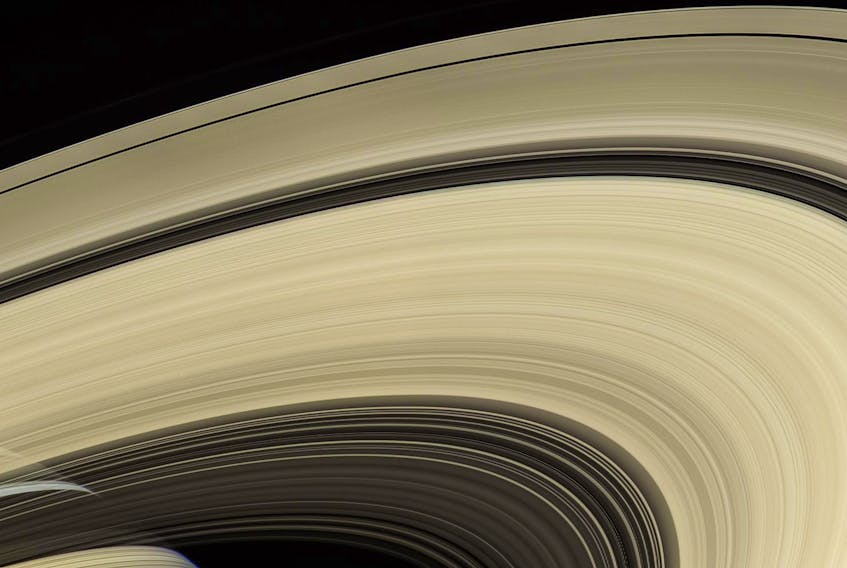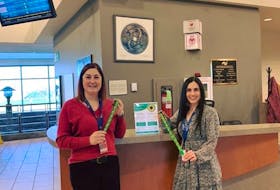Next planet out from the sun is Saturn, the sixth planet, and, undoubtedly, the most spectacular and beautiful planet to look at in a telescope.

Tolkien references aside, Saturn is the second-largest planet in our solar system, after Jupiter. It gets its name from the Roman god of generation, plenty, wealth and agriculture. Saturn was associated with the Greek god Cronus (son of Uranus, the sky and Gaia, the earth). According to Roman mythology, through an incestuous union with his sister Ops, Saturn is said to have fathered the gods Jupiter, Neptune and Pluto. Interestingly, it is probably from the Roman celebration of Saturnalia in Saturn's honour, held in the month of December, with its large, public feasts and festivities, that the origins of our present-day Christmas celebrations of gift-giving and feasting had their early origins.
Orbiting at an average distance of 1.4 billion kilometres (9.57 AUs) from the sun, Saturn's equatorial diameter is approximately 120,536 kms or 9.5x that of Earth's, while its mass is 95x that of Earth.
Saturn now (as of October 2019) has the distinction of having the most confirmed number of planetary moons (82, of which 53 are currently named) of all the solar system's planets, displacing Jupiter, which formerly held the title of the planet with the most moons (79). Saturn's largest moon, Titan, is the second largest moon in the solar system after Jupiter's Ganymede, is the only moon with a significant atmosphere, and is actually larger than the planet Mercury. The 82 known Saturnian moons do not include the hundreds of "moonlets" embedded in the planet's ring system.
Like its celestial neighbour, Jupiter, Saturn is a "superior" planet, in that it orbits outside the orbit of Earth, and, as such, does not pass between the Earth and the sun. Like Jupiter, it is best viewed when at opposition (opposite the sun in the night sky as seen from Earth), when it is at its brightest. Saturn orbits the sun every 29.37 Earth years. Its atmosphere, like Jupiter's, is composed primarily of hydrogen (96.3 per cent), helium (3.3 per cent), methane (0.4 per cent), as well as lesser amounts of ammonia, water vapor and other gases.
As with Jupiter, Saturn's high rotational speed (9.6 kms/second) causes its upper atmospheric layers to stretch into colourful (though muted compared to Jupiter's) cloud bands that circumnavigate the planet. Because Saturn's rotational period at its equator is faster (10 hours, 13 minutes and 59 seconds) compared to that at its poles (10 hours, 39 minutes, 24 seconds), Saturn appears more flattened (oblate) at its poles than does Jupiter, where the differential between pole and equator rotation periods is only about 5 minutes.
Though not possessing the long-lived storm systems of Jupiter's cloud bands, Saturn does, upon occasion, possess numerous swirling cloud cell systems which last several weeks or months.
Saturn, again like Jupiter, is thought to have a rocky core, surrounded by a small layer of liquid ices, then a much larger layer of helium and liquid metallic hydrogen, overlaid by a large layer of ordinary hydrogen. So dense is Saturn's atmosphere that, like Jupiter, no spacecraft would survive to reach the planet's inner core, due the hurricane winds, enormously high temperatures and extreme pressure.
The Pioneer 10 spacecraft was the first to flyby Saturn in 1973, followed by Pioneer 11 and Voyager's 1 and 2 in 1979. The first spacecraft to orbit Saturn was Galileo (1995-2003). The long-lived Cassini - Huygens mission (2004-2017) provided a wealth of information about both Saturn and its brilliant rings before running out of fuel and, in order to prevent contamination of any of Saturn's moons by microbes from Earth, was purposefully injected into the Saturnian upper atmosphere, where it was destroyed.
Saturn's magnificent ring system is composed primarily of countless ice fragments (with some rocky material), which reflect 80 per cent of the sun's light hitting them, thus greatly enhancing their visibility. The system, which lies in the planet's equatorial plane, is divided into numerous "rings", much like the circles around a bull's-eye target. These rings were (likely) first observed by Galileo in 1610 as two "lumps" on either side of the planet. It wasn't until 1655, when the Dutch astronomer, Christiaan Huygens, using a better-quality telescope than Galileo's, confirmed the existence of a ring system around Saturn.
The three primary rings have been labelled "A", "B" and "C". Rings "A" (the outer) and "B" (the inner) are separated by a distinctive gap known as the Cassini Division, named after the Italian astronomer Gian Domenico Cassini, who was the first reported astronomer to observe the gap between the two rings in 1675; the "C" ring (inside the "B" ring) wasn't discovered until the mid-1800s.
The various spacecraft flybys/orbits of Saturn have shown these three major rings to actually be composed of hundreds upon hundreds of smaller bands or "ringlets", many of which contain small "moonlets"; even the "A" ring has a gap (the Encke Gap) in it. The rings vary in width, density (number and size of ice fragments) and brightness (more/larger fragments equal a brighter ring); both the Cassini Division and the Encke Gap only appear dark due to lower concentrations of ice fragments in them.
Saturn, along with Jupiter, is still visible in the southwest sky at dusk, before setting around 10:30 p.m. In the coming weeks, Mercury, Venus and Mars will, once again, be visible.
Until next time, clear skies.
Glenn K. Roberts lives in Stratford, P.E.I., and has been an avid amateur astronomer since he was a small child. He welcomes comments from readers, and anyone who would like to do so is encouraged to email him at [email protected].
More ATLANTIC SKIES
Mercury - Messenger of the Gods
Planets and comets occupy October's skies
Next week - Uranus.








